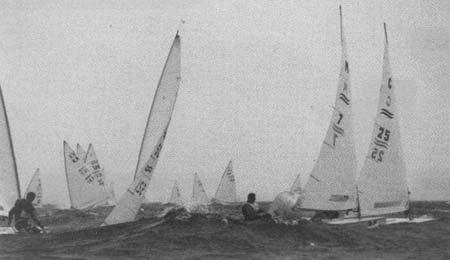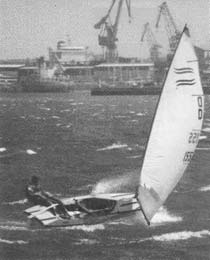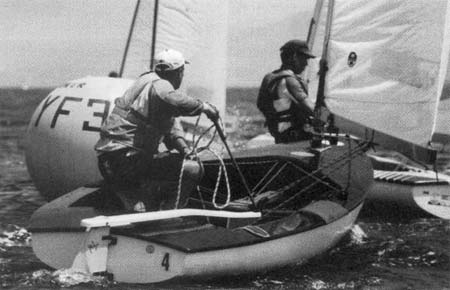| 33. Campaign Management |
by Gus Miller |
|
If you do an Olympic campaign, make certain that you make a commitment to excellence and then this will carry you through. Win or lose it will be one of the greatest things you have done in your life. Enjoy the competition and the people you meet. These are things you will remember for a long time. Success will come though from hard work, effort, discipline and joy. Don't leave any stone unturned.
|
 |
Also, it is important to have other goals that continue past the Olympics. Otherwise you can burn out. Sport is an end in itself, not the means to satisfy any individual or group vanity. Any trace of jealousy or animosity has no place. In the long run, whoever turns out to be the victor or the vanquished makes little difference. What is remembered is the participation and the effort to do your best along the way. Character and not complaints in the face of adversity are what is important.
John Wooden never preached winning, what he sought was effort which is something a little less tangible. "Cervantes said it is better to travel hopefully than to arrive. I always, from the beginning, enjoyed planning my practices and conducting my practices more than I did the games. My definition of success is peace of mind. That can be obtained only in self satisfaction."
|
|
One of the wonderful things about sailboat racing is that most racing fleets have a range of levels in them and the randomness of the wind allows those at the rear of the fleet an occasional chance to be up front. For many, it is a joy just to be part of the race, playing with the wind. For others, as the exploration of excellence in sailing works to higher levels of competition, eventually the question comes, "How does a sailor achieve the possibility of a high finish in a World Championship Regatta or an Olympic Regatta?" Part of the answer to this question is that old saw, "Proper prior preparation prevents poor performance".
This chapter will examine some important preparation areas that include: Boat Handling, Boat Preparation and Technology, Boat Speed, Physical Fitness, Psychological Fitness, Racing Savvy, Strategy, Tactics and Training Techniques. The elusive other part is indicated by remembering that the best prepared, the smartest, the strongest, the most talented and the fastest are not inherently the winners.
|
The intangible is 99% mental at the highest level. The winner at this level will have a consistent, centred focus of concentration and this chapter will also examine the challenges of that kind of concentration.
Proper Prior Preparation
Hard work usually beats talent. Make a commitment and strive for excellence; keep a professional approach and identify and work on your weaknesses.Some of sailing is luck, but in the end it is the foundation of fundamentals that counts. It is not just what is right, but what is wrong in your repertoire: finding out what you don't do well and eliminating the weakness. It is easy to train to your strengths, but they will take care of themselves. Most find their weak points uncomfortable, unenjoyable and because they are difficult and ego deflating, they shirk them in training. If you don't overcome this and practise weak areas, then in tough competition and when under pressure you'll come apart and self destruct. Every great Finn sailor has had a period where he lived in the cockpit of his Finn. It has to fit like a shoe. After strapping on your hiking pants, you strap on the boat.
|
 |
|
Get Organised - Have a Plan
Sailboat racing is a complex game. It makes a difference if you take the time to write goals down.
These might be:
Major - central - wish Goals
Objective - task Goals
Implementation - action Goals
Arrange milestones to reevaluate your goals to check on your progress at various stages. Keep a diary or a log. This is the only reliable way to keep track of all the details. At milestones or before major regattas, review the record and evaluate your diary and look for patterns and then work on your weaknesses.
Whenever you pick the brains of some smart sailor, write it down because he probably said some things you won't understand for six months or more. The act of writing will make you reflect and develop a deeper understanding of the game. |
 |
Boat Preparation and Technology
Details, details, details and more tiny details. Have the finest gear that you can possible get. Every part of the boat is optimal, so make sure it is tested and proven. Does your racing machine really measure in or is it just another good looking dinghy? There is no excuse for breakdowns. Make boat preparation check lists - all the big and the little things. Don't commit to or favour one sailmaker but respect their wishes. Thorough testing in tuning and combat - rational, unemotional testing. Consider: centreboard fairness and alignment, rudder cord, length & depth legal? Make sure the rudder isn't cocked and that the fittings are tight and fluid. Is the tiller length right for your arm and body size? Put calibration marks on all sail controls: outhaul, Cunningham and inhaul etc. so you can accurately evaluate sail setting positions and record and reproduce fast settings.
|
|
Boat Handling
Drills, drills and more drills. These should be rigorously rehearsed and consistently done.
Things like:
-
Little Piggy in the Middle,
- Pandora's Box
- Tacking & Gybing Drills
- Two buoy tacking and gybing chase drill
-
Ten minute crusher drill - who can work the
hardest all out the longest. (Your goal is to
win on every exchange: gybes, tacks, mark
roundings.)
- Starting technique
- Rabbit Starts
- Acceleration starts
- Stalling, slowing and manoeuvring around
other boats.
- 720°s beating & running
-
Righting from a capsize quickly. (Jose
Doreste was capsized by a huge breaking wave
in 25 knots of wind on the last reach of the
last race in the 1988 Olympic Regatta, but still
won the Gold.)
Boat Speed
Learn about sail and rig trim and what to do to coax speed out of the boat, especially in wave and wind transitions. The boat set-up transitions between different winds should be automatic. Also learn the differences in the boat set-up for different tactical situations and steer to that setup. Remember that most boat speed comes from training sessions with a better partner.
Concentrate on
- Steering
- footing speed and pointing speed
- Waves offwind, Waves pointing
- Kinetics and pumping technique
|
|